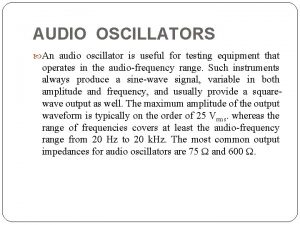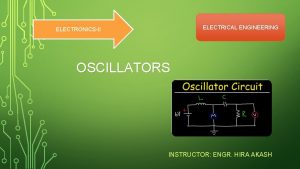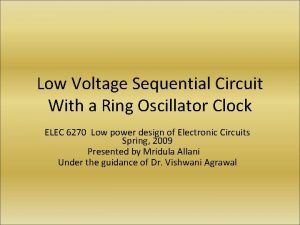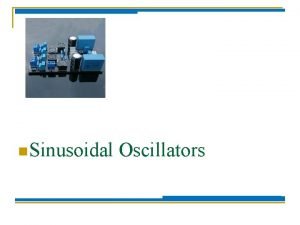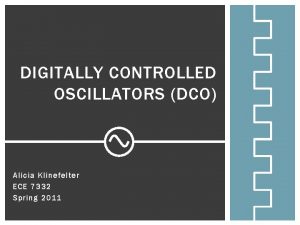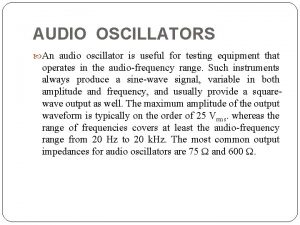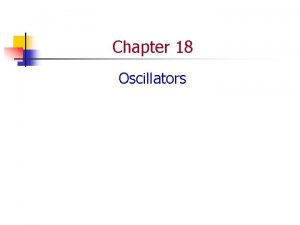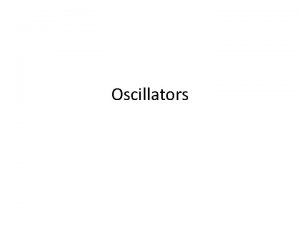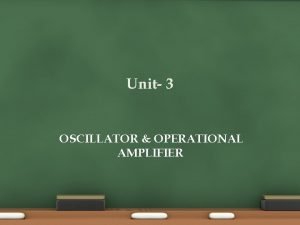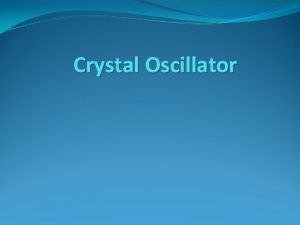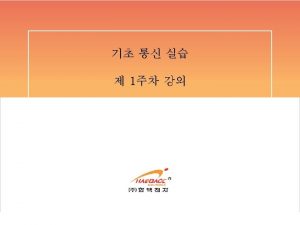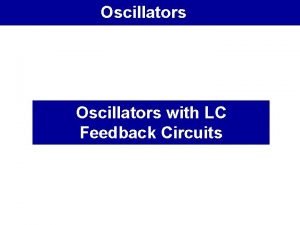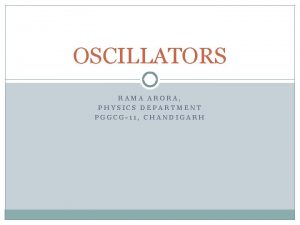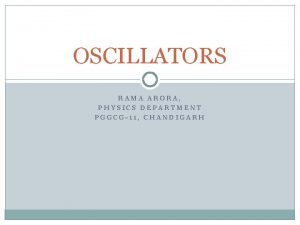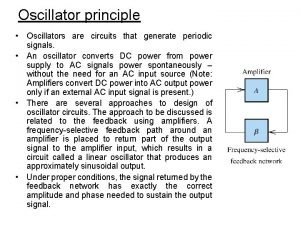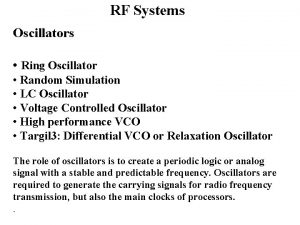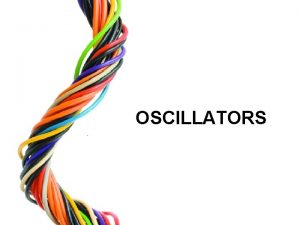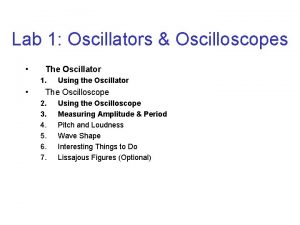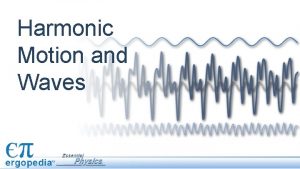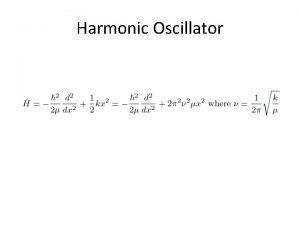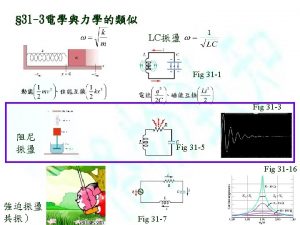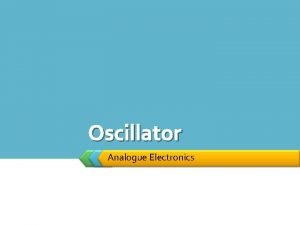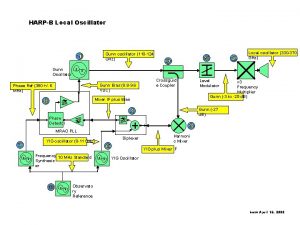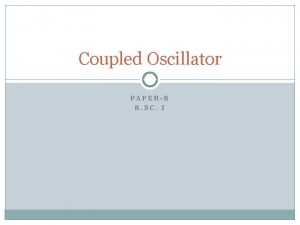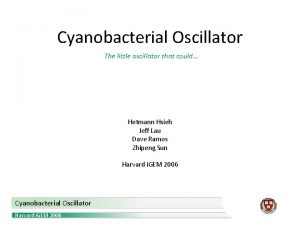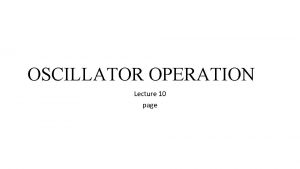AUDIO OSCILLATORS An audio oscillator is useful for


























- Slides: 26

AUDIO OSCILLATORS An audio oscillator is useful for testing equipment that operates in the audio frequency range. Such instruments always produce a sine wave signal, variable in both amplitude and frequency, and usually provide a square wave output as well. The maximum amplitude of the output waveform is typically on the order of 25 Vrms. whereas the range of frequencies covers at least the audio frequency range from 20 Hz to 20 k. Hz. The most common output impedances for audio oscillators are 75 and 600 .

The two most common audio oscillator circuits are the Wien bridge oscillator and the phase shift oscillator, both of which employ RC feedback networks. The Wien bridge offers some very attractive features, including a straightforward design, a relatively pure sine wave output, and a very stable frequency.

Wien Bridge The Wien bridge oscillator is essentially a feedback amplifier in which the Wien bridge serves as the phase shift network. The Wien bridge is an ac bridge, the balance of which is achieved at one particular frequency.

Cont’d The basic Wien bridge oscillator is shown in Fig. 1 2. as can be seen. the Wien bridge oscillator consists of a Wien bridge and an operational amplifier represented by the triangular symbol. Operational amplifiers are integrated circuit amplifiers and have high voltage gain, high input impedance, and low output impedance. The condition for balance for an ac bridge is Z 1 Z 4 = Z 2 Z 3 (1 -2) Fig. 1 -2 Wien bridge oscillator.

Cont’d Where Z 3 = R 3 Substituting the appropriate into Eq. 1 2 yields Z 4 =expressions R 4 (1 3)

Cont’d if the bridge is balanced both the magnitude and phase angle of the impedances must be equal. These conditions are best satisfied by equating real terms and imaginary terms. Separating and equating the real terms in Eq. 1 3 yields. (1 4) Separating and equating imaginary terms in Eq. 1 3 yields (1 5)

Cont’d Where . Substituting for to in Eq. 1 5, we can obtain an expression for frequency which is (1 6) If C 1 = C 2 = C and R 1 = R 2 =R then Eq. 1 4 simplifies yield (1 7)

Cont’d and from Eq. 1 6 we obtain (1 8) Where f = frequency of oscillation of the circuit in Hertz C = capacitance in farads R = resistance in ohms

EXAMPLE 1 -1 Determine the frequency of oscillation of the Wien bridge oscillator shown in Fig. 1 3 if R = 6 and C = 0. 003 F.

Solution Using Eq. 1 8. we compute the frequency as

Wein Bridge It can be shown, by using ordinary ac circuit analysis techniques, that Eq. 1 2 is satisfied by the value of the components in the circuit in Fig. 1 3. The design of a Wien bridge oscillator can be approached by selecting an operating frequency and level of current that will be acceptable through each arm of the bridge. The bridge currents are typically larger by at least a factor of 100 than the maximum input current to the amplifier, and the peak value of the sinusoidal output voltage is typically on the order of 90% of Vcc.

EXAMPLE 1 -2 Design a Wien bridge oscillator around the following specifications: F = 15 k. Hz Vcc = 10 V /in = 1 /R 4 = 100/in

Solution If the peak value of the sinusoidal waveform is 90% of Vcc, we can solve for the value of R 3 + R 4 as Using Eq. 1 7, we can say that R 3 = 2 R 4

Cont’d Therefore 3 R 4 = 90 R 4 = 30 and R 3 = 2 R 4 = 60

Wein Bridge We arrived at Eq. 1 7 by letting R 1 = R 2 = R. It is generally convenient to let R 1 = R 2 = R 4 : therefore, R 1 = R 2 = 30 Using Eq. 1 8. we can now solve for the capacitance C as C=

Cont’d The Wien bridge oscillator is widely used in audio oscillators because of its relatively small amount of distortion, excellent frequency stability, compara tivelywide frequency range, and ease of changing frequency. A typical commercial Wien bridge oscillator can have a frequency range extending from 5 Hz to 500 k. Hz in decade steps.

Phase Shift Oscillator The second audio oscillator circuit of interest is the phase shift oscillator. The phase shift network for the phase shift oscillator, is an RC network made up of equal value capacitors and resistors connected in cascade. Each of the three RC stages shown provides a 60 o phase shift. with the total phase shift equal to the required 180 o.

Cont’d circuit. Fig. 1 4 Basic phase shift oscillator

Cont’d The phase shift oscillator is analyzed by ignoring any minimal loading of the phase shift network by the amplifier. By applying classical network analysis techniques, we can develop an expression for the feedback factor in terms of the phase shift network components. The result is (1 9)

Cont’d If the phase shift of the feedback network satisfies the 180 o phase shift requirements, the imaginary components of Eq. 1 9 must be equal to zero or

Cont’d The frequency of oscillation for the circuit can be determined by substituting 2 for in Eq. 1 10 and solving for the frequency. The result is (10 11)

Cont’d We can express Eq. 1 11 as (1 12) or 1 13) ( substituting for in Eq. 10 9, we obtain 1 14) (

Cont’d or (1 15) Rewriting Eq. 1 15, we see that Vo = 29 Vi which means that the gain of the amplifier must be at least 29 if the circuit is to sustain oscillation.

EXAMPLE 1 -3 Determine the frequency of oscillation of a phase shift oscillator with a three section feedback network consisting of 13 resistors and 100 F capacitors.

Solution Using Eq. 1 11. we can compute the frequency Of oscillation as

Cont’d The phase shift oscillator is useful for noncritical applications. particularly at medium and low frequencies, even down to 1 Hz, because of its simplicity. However, its frequency stability is net as good as that of the Wien bridge oscillator, distortion is greater, and changing frequency is inconvenient because the value of each capacitor must be adjusted. The choice of an oscillator circuit to operate in the audio frequency range is determined by the particular application.
 Audio oscillators
Audio oscillators Classification of oscillators
Classification of oscillators Low g oscillators 50low
Low g oscillators 50low Sinusoidal oscillators are
Sinusoidal oscillators are Alicia klinefelter
Alicia klinefelter The figure shows four oscillators at t=0
The figure shows four oscillators at t=0 Anatomi organ reproduksi
Anatomi organ reproduksi Stig kerman
Stig kerman Strategi för svensk viltförvaltning
Strategi för svensk viltförvaltning Vad är verksamhetsanalys
Vad är verksamhetsanalys Typiska novell drag
Typiska novell drag Tack för att ni har lyssnat
Tack för att ni har lyssnat Klassificeringsstruktur för kommunala verksamheter
Klassificeringsstruktur för kommunala verksamheter Cks
Cks Läkarutlåtande för livränta
Läkarutlåtande för livränta Påbyggnader för flakfordon
Påbyggnader för flakfordon Tack för att ni lyssnade
Tack för att ni lyssnade Inköpsprocessen steg för steg
Inköpsprocessen steg för steg Egg för emanuel
Egg för emanuel En lathund för arbete med kontinuitetshantering
En lathund för arbete med kontinuitetshantering Atmosfr
Atmosfr Variansen formel
Variansen formel Rutin för avvikelsehantering
Rutin för avvikelsehantering Vad är vanlig celldelning
Vad är vanlig celldelning Myndigheten för delaktighet
Myndigheten för delaktighet Presentera för publik crossboss
Presentera för publik crossboss Var 1721 för stormaktssverige
Var 1721 för stormaktssverige
